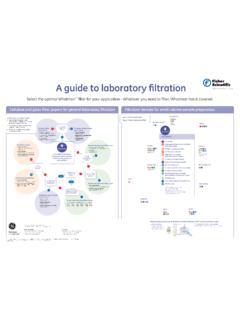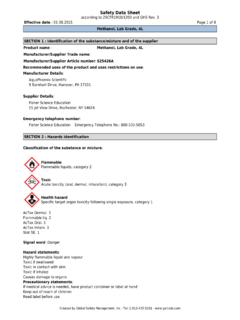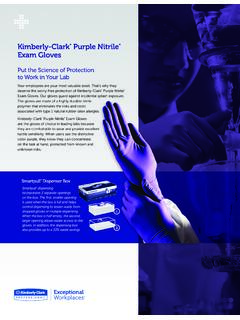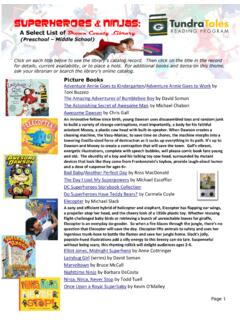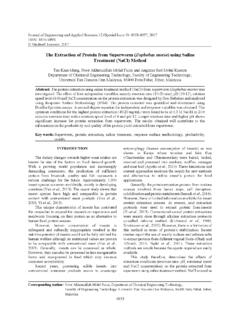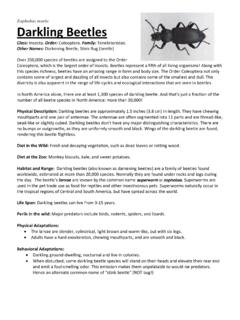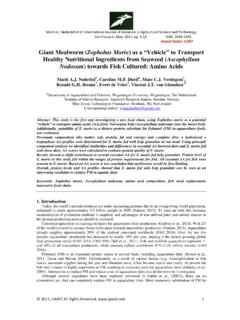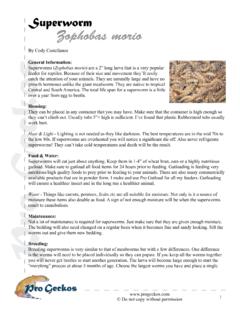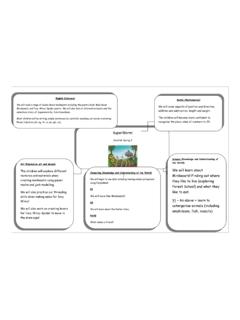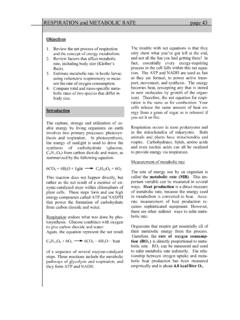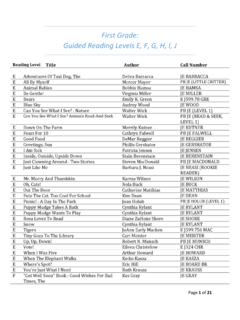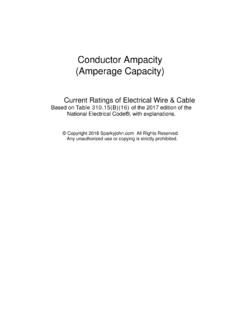Transcription of Carolina Arthropods Brochure - beta-static.fishersci.com
1 Carolina ArthropodsWorld-Class Support for Science & MathCarolina Athropods ManualContentsIntroduction ..5 USDA Safeguards for Insect Pests ..5 Amphipods ..6 Ants ..7 Beetles ..8 Bean Beetles ..8 Bessbugs ..8 Convergent Lady Beetles ..9 Darkling Beetles (Mealworms, Superworms) ..10 Dermestid Beetles ..11 Diving Beetles ..13 Flour Beetles (Tribolium) ..13 Butterflies ..14 Brassica Butterflies ..14 Painted Lady Butterflies ..15 Care of Adult Butterflies ..16 Brine Shrimp ..16 Centipedes and Millipedes ..18 Cockroaches ..18 Madagascar Hissing Roaches ..19 Copepods and Ostracods ..20 Crayfish ..20 Damselfly and Dragonfly Nymphs ..21 Daphnia ..21 Drosophila ..22 Fiddler Crabs ..22 Ghost Shrimp ..23 Giant Water Bugs ..24 House Crickets ..24 House Flies ..25 Isopods ..27 Aquatic Isopods ..27 Terrestrial Isopods ..28 Jewel Wasps (Nasonia) ..28 Land Hermit Crabs ..30 Milkweed Bugs.
2 31 Moina ..32 Mosquitoes ..33 Moths ..35 Greater Wax Moths ..35 Hornworms ..36 Luna Moth and Saturniid Moth Cocoons ..39 Silkworms ..40 Praying Mantids (Mantises) ..42 Sarcophaga ..43 Scorpions ..44 Spiders ..45 Tarantulas ..47 Termites ..48 WOWBugs ..49 For your convenience, we have listed throughout this manual the catalogitem numbers of some of the products available from Carolina BiologicalSupply Company. For more information, please refer to the most recentCarolina Science catalog, call toll free 800-334-5551, or visit our Web siteat 2009 Carolina Biological Supply CompanyPrinted in USA5 IntroductionCarolina Biological Supply Company maintains a large variety of livingarthropods for use in teaching and research. Animals leaving ourlaboratories are healthy, but we have no control over shipping animals may be traumatized during shipment, so it is criticalthat you give them your full attention immediately upon hope you find this information useful for maintaining and using livingarthropods in the classroom and laboratory.
3 We have developed this manualin an attempt to provide relevant background information for each arthropod ,including its nutritional requirements and proper habitat setup. For species-specific information, we recommend consulting textbooks, species-specificpublications, journal articles, the Internet, or an arthropod Safeguards for Insect PestsIf you ordered bean beetles, cabbage white butterflies, flour beetles,greater wax moths, harvester ants, hornworms, subterranean termites, orsuperworms (Zophobas morio), you must adhere to the Departmentof Agriculture Standard Safeguards listed below. Your state regulatoryagency has required that these safeguards be followed for keeping andusing these insects. Other insects also may be regulated in your state laws regulating live insects can change without notice, westrongly recommend following these guidelines for all pest insect Standard Safeguards1. Upon receiving living pests, all packing material media, substrate, soil and shipping containers shall be destroyed immediately uponremoving Pests shall be kept only within the laboratory, classroom or designated area at the purchaser s No living pests kept under this permit shall be removed from confined area except by prior approval from State and Federalregulatory Without prior notice and during reasonable hours, authorized Plant Pest Quarantine and State regulatory officials shall be allowed to inspect the conditions under which the pests are All pests kept under this permit shall be destroyed at the completion of the intended All necessary precautions must be taken to prevent escape of on Releasing OrganismsCarolina provides living organisms for educational purposes only.
4 As ageneral policy, we do not advocate the release of organisms into theenvironment. In most states, it is illegal to release organisms, evenindigenous species, without a permit. The intention of these laws is toprotect native wildlife and the completing classroom activities, we suggest that organisms be maintained in the classroom. donated to another classroom or science department. donated to a nature center or zoo. humanely disposed of, as a last are commonly referred to as sideswimmers, because theyoften swim on their sides. Carolina supplies freshwater amphipods. Theyare primarily scavengers of plant and animal material; however, they havebeen known to attack injured or stressed receipt, remove the lid from the shipping jar and allow it to just sit onthe jar, but do not aerate the culture with a pipet or any other device. Keepthe jar in a cool area (21 C, 69 F) out of direct sunlight. The optimal habitatfor amphipods is a glass or plastic container ( , a 20-liter or largeraquarium) filled with springwater or bottled water.
5 Note:Do not usedistilled water or municipal tap water. The organisms are sensitive to metalions, which are usually present in at least trace feed on algae as well as bacteria and yeast. Place a few smallpieces of algae in the habitat. To prepare a yeast suspension as food foramphipods, mix baker s yeast and springwater in a clean 2-liter soft drinkbottle. Add baker s yeast until the water becomes milky, then store in arefrigerator. Always agitate the water before use to resuspend the yeast,and feed amphipods a few drops each day. An alternative is to crush threeor four grains of dry baker s yeast on clean paper and dust this on thesurface of the culture. Avoid overfeeding. Do not allow the water in theculture to become clouded. Draw off and discard about one-fourth of theculture water and replace it with new springwater on a weekly supplied by Carolina can be stored for up to 2 weeks in the ready for use, check the ants daily with special attention to themoisture content of the culture.
6 If the culture is too damp, use a fine meshscreen as a temporary cover to allow moisture to escape. Remove any mold;however, if there is excessive mold, move the ants to a fresh container witha very small piece of potato or apple for food and moisture. If the cultureseems too dry, add damp paper, cotton, or sponge to the , the inhabitants of ant farms are worker harvester ants. Beforeintroducing the ants into the ant farm or habitat, place them in arefrigerator for 5 10 minutes. Do not place them in a freezer, as extremelycold temperatures will kill them. Roll a piece of paper into the shape of afunnel. Remove ants from the refrigerator, and pour them through thefunnel into the ant farm. Caution:Do not touch the ants, as they are able todeliver a painful, stinging may take 12 24 hours for the ants tobecome acclimated to their new home. Although their activity level is high,their nutritional demands are low. Feed your ants a small piece of fruit orvegetable every 2 or 3 days.
7 Remove any uneaten food after 2 days toprevent mold from accumulating. Provide your ants with a few drops ofwater every day, and maintain them in a cool room at 16 21 C (60 70 F).With proper care, harvester ants will live 2 4 ants are active at night. It is then that they leave the nest toforage for food. Carpenter ants feed on sources of protein and sugar. Theirtypical foods include aphid honeydew, other insects, plant juices, and foodproducts containing fat, meat, or sugar. Other foods eaten by carpenterants include syrup, honey, jelly, pieces of sweetened cereal, and a sugar-water solution on a sponge. Remove uneaten food before it ants do not eat wood. The carpenter ants we ship are normallyused as a food source for other animals. They should be kept in cool areas(such as a refrigerator) until needed, so that they will survive longer and beeasier to handle due to their sluggish life cycle of carpenter ants is an example of complete metamorphosis,with egg, larval, pupal, and adult stages of development.
8 Depending ontemperature, the life cycle can take from 3 months to a year to ants have an average lifespan of 7 years, while queen ants may liveas long as 25 :Harvester ants are potential agricultural pests. Do not release them intothe environment. It is illegal to ship queen ants, due to the threat of BeetlesBean Beetles, Callosobruchus maculates, are pests of stored legumes(Fabaceae). The larvae require the seeds for nutrition, while the adultbeetles do not require food or water. Culturing bean beetles is simple, asthe only materials needed are dry beans and a container that will preventthe beetles from escaping. We recommend using organic mung beans andblack-eyed peas (cowpeas). It is best to maintain a ratio of one or two adultbeetles per bean, and temperatures between 22 C and 30 C (72 F and86 F). Keep all cultures out of direct sunlight and away from heat begin a culture, cover the bottom of a container with a single layer ofbeans equivalent to a volume of 50 mL.
9 Add 10 adult males and 10 adultfemales to the container. Adult females are black in color with an enlargedabdomen that has dark stripes on each side of the abdominal plate. Malesare a brownish color with a smaller abdomen that lacks stripes. Femaleslay their eggs on the surface of host beans. The eggs will hatch 4 5 dayslater. The larva hatches from the egg, burrows into the bean, and feeds onit. While still inside the bean, the larva goes through a series of molts andthen pupates directly under the skin of the bean. The adult will chew throughthe skin of the bean when it is ready to emerge. Adults live 1 2 weeks, andspend that time mating and laying eggs. The entire life cycle of the bean beetle, from egg to adult, takes from 3 7 weeks. The length ofmetamorphosis is dependent upon temperature and :Bean beetles are potential agricultural pests. Do not release theminto the environment. Prior to disposal, place the live cultures in a freezerfor at least 3 days to ensure that all the beetles are (Passalus cornutus), or shorthorned stag beetles, can be kept fora considerable length of time if provided with a supply of damp, slightlydecaying hardwood (oak is preferred).
10 The beetles are shipped with agenerous amount of wood, which should last several 4 5 cm of moist potting soil or humus in a terrarium as a some leaf litter and the beetles, along with the rotten wood that wasshipped with the animals. Do not place terraria in direct sunlight, as thismay overheat and kill the beetles. Maintain the beetles at roomtemperature (20 22 C, 68 72 F). Bessbugs require humidity, so keep thesoil damp and mist the habitat daily. However, if mold becomes a problem,increase the ventilation or reduce the amount of misting. Bessbugs eatmicroorganisms found in wood, chewing through damp, rotting wood to9create tunnels inside the log where they live. If they eat all the rotten woodshipped with them, collect additional rotten hardwood locally or order itfrom Carolina (14-4153).Bessbugs can live as adults for up to 11 2years, which is unusually long fora beetle. They also undergo complete metamorphosis, so their entire lifecycle (egg, larva, pupa, and adult) can extend beyond 2 years.





